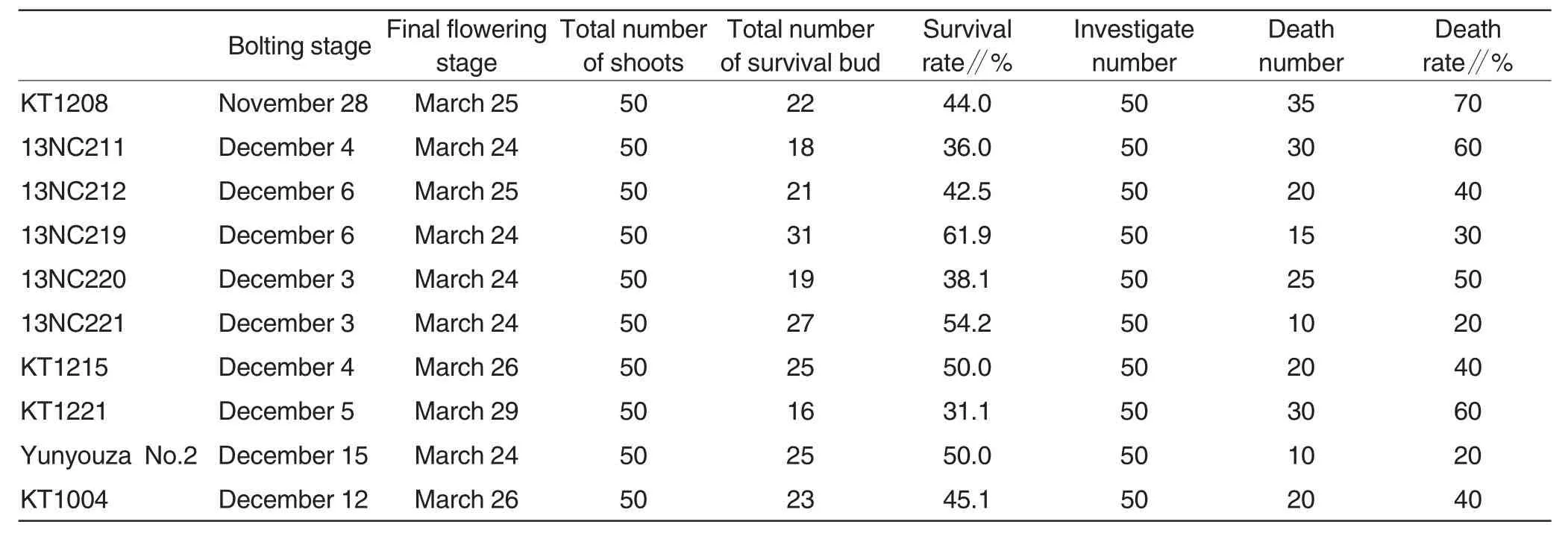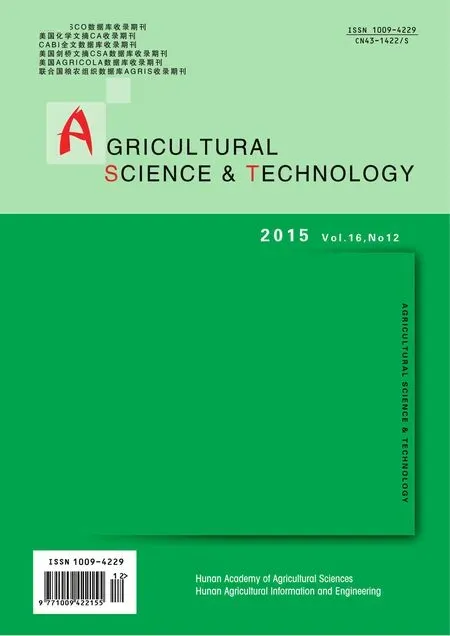Remedial Technical Measures Following Freezing Injury of Rapeseed
2015-02-25XiaoyanZHOUMeilingZHANGYatingLIUBingWANGQinggangLICuipingZHOULiangbinLINYuankuanLEI
Xiaoyan ZHOU,Meiling ZHANG,Yating LIU,Bing WANG,Qinggang LI,Cuiping ZHOU,Liangbin LIN,Yuankuan LEI*
1.College of Agronomy and Biotechnology,Yunnan Agriculture University,Kunming 650201 China;2.Luoping Seed Control Station,Qujing 655800,China,
Rapeseed is one of four oil crops in China.Colza oil represents 40% of national consumption of edible oil and rapeseed cake represents 25% of plant-based cake.Luoping County is a national rapeseed production base,as well as a major rapeseed-producing county in Yunnan Province.The county is famous as"Oil Depot in Yunnan",where rapeseed area reaches about 1/6 of provincial area and total yield about 1/5 in the province[1].However,influenced by successive natural disasters such as drought and freezing injury,rapeseed production in Luoping is challenged.From 2008 to 2010,for instance,rapeseed area was increasing,but per unit area yield kept decreasing affected by low-temperature freezing and frost,and drought[2].It is notable that rapeseed is mainly affected by freezing injury in winter featured by averaged temperature of-0.5-3.0℃and minimal temperature at-8℃--5℃,when vegetative growth and reproductive growth proceed simultaneously,so that rapeseed tends to be frozen[3]and both yield and quality be influenced.Therefore,it is necessary to take anti-freezing and heat-preservation measures to guarantee safe overwintering of rapeseed with consideration of freezing injury symptom and causes,including selecting coldness-tolerant cultivar, rationalarrangement of sowing term,removing early-growing stalks and flowers,controlling disease and insect damages,rational fertilization and water management[4].Li et al.[5]explored the effects of sowing term,planting density,the height of preceding crop stubble and fertilization on coldness tolerance and yield of rapeseed Zhongshuang No.9 and the results showed that the effects from sowing term,planting density,potassium and phosphorous fertilizers dominated,followed by the height of preceding crop stubble.Forexample,the planting density of 3.15×104plant/hm2proved conductive to reduction of freezing injury and increase of yield for rapeseed;P and K fertilizers enhanced tolerance of rapeseed,but N fertilizers lowered the tolerance.

Table 1 The survey on rapeseed killed by frost
In general,rapeseeds sown in winter underwent three severe freezing injuries from 2013 to 2014,posing threats to rapeseed production in varying degrees.For example,the minimal temperature was-4.7℃and frost last four successive days from December 17 to December 20;the second frost term was from January 20 to January 23 in 2014,with the lowest temperature at-2.9℃;the third term started from February 18,with the minimum temperature at-1.8℃.The research investigated the measures of cutting stalk and correlation with yield after freezing among 10 rapeseed cultivars,providing references for relieving freezing injury and guidance of rapeseed production.
Materials and Methods
Materials
The test materials were 10 rapeseed cultivars, including KT1208,13NC211, 13NC212, 13NC219,13NC220, 13NC221, KT1215,KT1221,Yunyouza No.2 and KT1004.
Methods
PlantingThe test materials were arranged as per randomized block and every test plot has an area of 2 m×5 m,with three replications.
Specifically,the frozen rapeseed stalk was cut in the afternoon of January 15,2015 and it is notable that the frozen stalks and leaves were removed from main stalk with a sickle in case of re-injury.The control contained rapeseeds without removing stalks.
Additional nitrogen fertilizers(urea)should be applied in every test plot at 105 kg/hm2on January 4,2014;aphids should be controlled with imidacloprid and Jindu Shiling (a kind of pesticide)on February20 and March 1.
Sampling and exploration on seeds
When rapeseeds grew mature,10 plants were sampled from every test plot to explore the 1st and the 2nd-effective branch numbers,the number of plant silique number per plant,the number of seed per pod,and thousand-seed weight.
Data processingThe data were processed with Excel 2003 and analyzed with SPSS.
Results and Analysis
Tolerance of different cultivars on freezing injury
It is notable that 2013 is the year when freezing injury was featured by the highest frequency and the severest intensity.According to freezing injury index of flowering and podding stages in Yunnan[1],the three freezing injuries are much serious,corresponding to bolting stage of 4 d,squaring stage of 3 d and flowering and podding stage of just one day.The minimum temperatures were-4.7,-2.9 and-1.8℃.As shown in Table 1,the survival rate tended to be volatile upon cultivars.Forexample,the survivalrate of 13NC219 was the highest at 61.9%.Besides,coldness-tolerance capacity also differed dramatically in the range of 20% -70%,and KT1208 proved the highest at 70%,and Yunyouza No.2 and 13NC221 the lowest at 20%.It can be concluded therefore that it is effective to select rapeseed cultivar tolerant to coldness.
Effects of removing rapeseed stalk
As shown in Table 2,after removing rapeseed stalk,the number of the 1st effective branches showed a small increase and the 2ndeffective branch a big increase,dominated by 13NC220.Furthermore,the plant silique number per plant grew considerably;the seed number per pod decreased,except of 13NC219; thousand-seed weight maintained unchanged and yield per plant was increasing.These demonstrated that the measure of removing rapeseed stalk would improve the number of effective branches,the number of pod and yield per plant.In addition,the yield per plant varied significantly upon cultivars after removing the stalks.For instance,the yield of KT121 was the highest at 42.68 g and of KT1004 the lowest at 17.70 g.For the same cultivar,the yield per unit area was also different on whether rapeseed stalk was removed.Except of Zayou No.2,the yield per unit area all increased dramatically after removing stalks.These incorporated that the practice of removing rapeseed stalk would significantly yield per plant after freezing and the objective is to advance branch growth and increase the number of effective branch and pod.
Correlation analysis
Many concerning items were computed with SPSS covering the number of effective branch,the number of plant silique per plant,the number of seed per pod,and correlationwith yields.The results showed that the thousand-seed weight and the number of the 1st effective branch showed inverse correlation with yield per plant,which indicated freezing injury almost has none effects on the two items.However,the 2ndeffective branch number,the number of seed per pod,and the number of plant silique per plant showed positive correlation with yield,and the correlation coefficient of number of pod per plant and yield reached 0.818,which suggested that the number of pod per plant is the most affected by freezing injury.Hence,the item of pod number per plant can be taken as the investigation index for rapeseed tolerance to coldness.On the other hand,yield traits showed positive correlation with yield per plant for those with stalk removed after freezing;thousand-seed weight showed the most significant correlation at 0.517 with yield per plant and the number of the 1steffective branch was of the most insignificant correlation at 0.225,which incorporated that yield traits of rapeseed could recover to a certain extent by removing stalks afterrapeseeds undergo freezing injury.

Table 2 Effects on agronomic traits and yield of rapeseed

Table 3 The correlation of yield traits and yield per plant(Pearson correlation)
Discussions
In Luoping,the rapeseeds suffered freezing injury in farmlands with temperatures in-4.7℃--1.8℃,causing iced leaves,stems,branches,flowers and pods.Specifically,when temperature drops below the freezing point,waterin intercellularspace would freeze,because the concentration in intercellular space is lower than that of cell sap.After the freezing,the flow of water in intercellular space would decline and intercellular water move outward,increasing ice crystals.On the following day when temperature rises substantially,the water obtained by ice crystal melting would be evaporated before absorbed by cells,resulting in withering of rapeseed[6].Considering the effects of the number of effective branch and the number of seed per pod,it is necessary to give highlights to the aspects at selecting and breeding rapeseeds.
There are many ways for controlling freezing pressure on rapeseed.For example,Cao et al.[7]conducted measurements of coverage materials and time on Fengyou No.10 involving soil temperatures,freezing degree,economic traits,yield and quality upon soil horizons,and the results showed that soil coverage would effective adjust soil temperature,reduce freezing index,and improve survival rate of rapeseed.Baseoncomprehensive analysis,rapeseeds frequently suffer freezing in growth term and it is recommended to take measures corresponding to specific situations covering freezing time and degree,as well as growth term of rapeseed.For instance,ditch cleaning and draining should dominate in seedling stage,especially in lowlands,which would lower water table and farmland humidity,enhance ground temperature and promote root growth.In bud stage,quick-acting fertilizer should be applied,as well as re-moving frozen stalk and leaf,for example,urea can be fertilized at 105-150 kg/hm2.In dry and rainfed farmlands,it is difficult for fertilizers to integrate with water,preventing rapeseed absorbing fertilizers and water and affecting rapeseed growth.It is obvious that rapeseed tends to be volatile in coldness tolerance upon cultivars,and it becomes crucial to select coldnesstolerant rapeseed cultivars.The research has demonstrated thatthe practice of removing rapeseed stalk after freezing would effectively improve yield per plant and yield traits would recover to a certain extent,which aims at advance base branch growth and increase the numbers of effect rapeseed branch and pod to enhance yield.It is notable that freezing injury has the most significant effects on the number of plant silique,which can be taken as an investigation index of rapeseed in tolerance of coldness.
[1]WANG HZ(王汉中).The book on disaster resistance and alleviation of rapeseed production in China(中国油菜生产抗灾减灾技术手册)[M].China Agricultural S&T Press(中国农业科学技术出版社),2009,10:141.
[2]HOU XG(侯旭光).Status quo and countermeasures of maize industrialization in Inner Mongolia(内蒙古玉米产业化发展现状与对策)[J].Journal of Henan Agricultural Sciences(河南农业科学),2006(11):15-18.
[3]BAO YH(包燕宏).The causes and countermeasures of freezing injury on rapeseed(油菜冻害的发生原因及防御措施)[J].Modern Agricultural Science and Technology(现代农业科技),2012(19):56-58.
[4]ZHENG LL(郑莉荔).Plant and plant physiology(植物及植物生理学)[M].Agriculture Press(农业出版社),1980,9(1):257-258.
[5]LI J(李 俊),ZHANG CL(张春雷),MA N(马 霓),et al.Effects of cultivation method on freezing resistance and yielding capacity of winter rape(栽培措施对冬油菜抗冻性和产量的影响)[J].Jiangsu Agricultural Sciences(江苏农业科学),2010(1):95-97.
[6]FU ML(符明联),LI GZ(李根泽),LI SQ(李淑琼),et al.The simplified cultivation technology of rapeseed in Yunnan (云南油菜轻筒化栽培技术)[M].Yunnan S&T Press(云南科技出版社),2013,7:95-98
[7]CAO JH(曹金华),ZHU JC(朱家成),ZHANG SF (张书芬),et al.Effect of covering on soil temperature and cold resistance and yield of rapeseed(Brassica napusL.)Fengyou 10(覆盖对土壤温度及甘蓝型油菜丰油10号抗寒性和产量的影响)[J].Chinese Journal of Oil Crop Sciences(中国油料作物学报),2014,36(2):213-218.
猜你喜欢
杂志排行
Agricultural Science & Technology的其它文章
- Study on Engineering Characteristics and Application of Sticky Rice
- Periodical Development Trend of Vertical Greening
- Advances in Microbial Remediation on the Application of Heavy Metal Pollution in Agricultural Water Resources
- Analysis on Status quo and Future Development of Fruit and Vegetable Protreatment
- Effect of Three Treatment Measures on Harmless Seedling Raising of Pinus sylvestris var. mongolica Litv.
- Discussions and Recommendations for Supervision of Vegetable Quality and Safety in Miyun County
